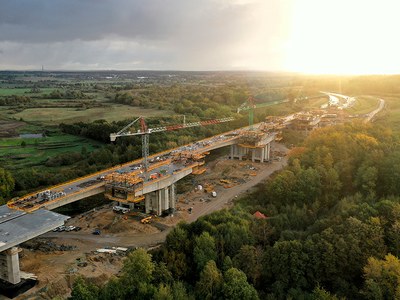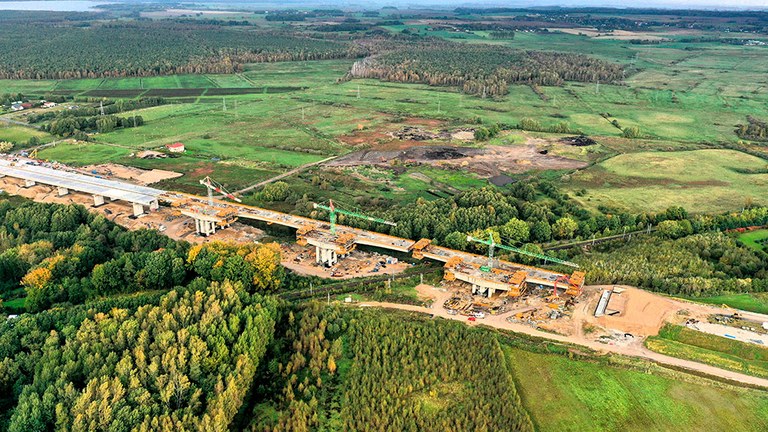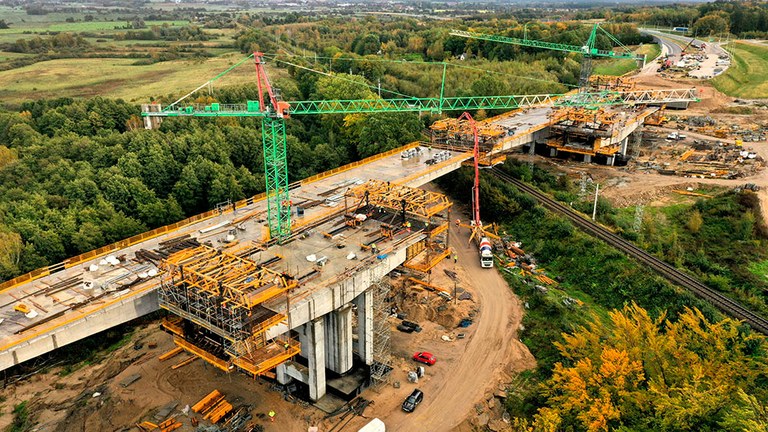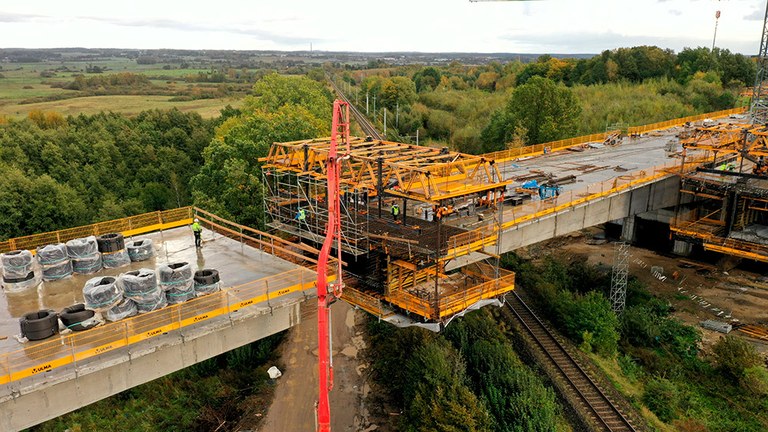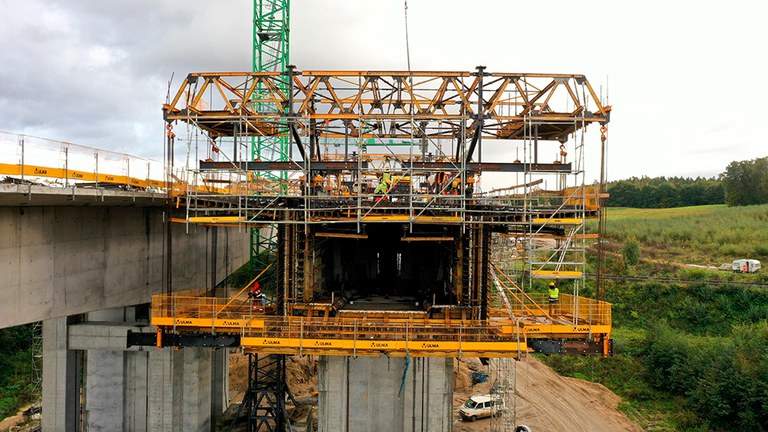Working on a key project in Koszalin, Poland
This crossing structure will make the S6 expressway a continuous motorway section, with a flyover crossing a single-track railway line and an already-existing provincial road. The construction methods used to build this structure will be a 6-span incrementally launched bridge and 4-span progressive cantilevers.
The use of building techniques involving incremental launching and balanced cantilever method is increasingly widespread in viaduct construction. Its efficiency is best demonstrated in projects with large spans and difficult terrain. It provides an advantage for the construction companies by ensuring on-site safety and good performance, while reducing the work force requirements for assembly and formwork operations. Nowadays, the overpasses construction process normally involves distribution over several sections, for which different construction methods are used.
The ES-119 viaduct is a good example of this. Made up of two independent decks and with a length of 760.89 m, it forms part of the S-6 expressway section. The incrementally launched section is 356 m in length, with 58.5 m spans and a 3.30 m deck thickness, while the rest of the structure was designed to be built using the balanced cantilever method, with spans of up to 130 m and a deck thickness varying between 2.79 and 6.26 m.
The first structure that will be built using this latter method is the so-called pier segment, which on completion forms the base to which the formwork system are fitted to create the successive cantilever segments. The pier segments located in piers at heights of over 10 m, meaning a heavy-duty shoring system with robust shores was required, and ULMA T-60 shoring towers were therefore used to shore the formwork on the pier segment. Given the small amount of free surface space on the footings, the solution of reinforced towers made it possible to install more shoring in the ground for the correct transmission of loads. With the T-60 shoring tower system, BRIO platforms and mobile stairs can also be used, guaranteeing safe access to the work area and an effective system for the workers to move around. The pier segment was built in two stages, each using the ENKOFORM HMK, a versatile system adaptable to the complex geometry of the works.
As to the cantilever section deck, it was built with the aid of CVS carriages. These carriages were designed for concreting segments measuring between 4 and 5 m in length, and 8 ULMA carriages were used on the works at the same time.
For safety, the CVS carriages are equipped with work platforms conveniently placed on the main structure and used to carry out form removal operations and formwork levelling for the base slab, during the stages following the carriage advancement operations. The carriages are also equipped with a system of suspended platforms created using BRIO multidirectional scaffolding elements, allowing safe access to the rear part of the structure. The other platforms – those at the sides and front – and the deck edge are protected with MBP metal edge protection. To guarantee an adequate working pace in 7-day cycles while observing the strict safety standards for carriage work, the carriages were equipped with three hydraulic systems. The basic hydraulic system is used for rail advancement and, after this, for moving the entire structure. The other two systems are used for anchoring and levelling the carriage after completion of the transfer to the next placement.
As to the section built using the incremental launching method, the formwork for the successive segments was configured using the ENKOFORM HMK system. This method requires installing an area for prefabricating the segments. The incremental launching area is placed on sliding girders. To speed up the reinforcement work, there is a scrap pre-fabrication workshop behind the concreting area, and both areas together make up the pre-fabrication area. Once the reinforcement has been prepared, it is propelled into the concreting area.
The sliding area supplied by ULMA had a length of 30 metres, enabling concreting of segments up to 29.25 m. For the launching process, the bridge was divided into 13 segments.
To guarantee adequate work performance, ULMA supplied hydraulic solutions and a stripping head system. The system of cylinders and sliding elements enabled the formwork to be removed from the whole mould in one single operation. This operation was carried out in under 30 minutes, and times of 3 hours or less were required for the subsequent formwork placement and mould levelling.
The incrementally launched bridge construction process requires adequate safety standards for the workers located on the different bridge piers and involved in the incremental launching procedures. Perimeter platforms were therefore supplied for each pier, directly anchored to the pier surface. BRIO ladders were installed to ensure access to the platforms.
The solutions proposed for the ES-119 viaduct, the carriages and the incrementally launched bridge fabrication area were designed using MK system components. This is a versatile system that adapts the shape of the formwork to the geometry of the work to be carried out, and it is also compatible with other ULMA solutions, meaning solutions can be offered to meet the highly demanding safety standards. In this case, the MBP metal edge protection were adapted to the CVS carriage platforms.
Incremental launching or progressive cantilever based procedures also require quick, safe operating of the hydraulic systems. The ULMA staff are on-site right from the start of the works to supervise the system assembly and start-up work, providing full support in all aspects of use of the equipment.
To guarantee the strict safety requirements are met and the optimum output maintained on building the crossing structure using incremental launching or progressive cantilever procedures, it is advisable to choose systems of proven efficiency and knowledgeable, experienced staff. The wide range of projects ULMA has delivered using these procedures and its personalised approach to customer contact enable us to offer the best tailor-made solutions for any project.
Enjoy the spectacular images of this project in this video.


